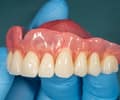But if you need dentures, you might require a surgery known as vestibuloplasty, often performed before placement of a prosthetic. The benefit this pre-prosthetic surgery provides is to deepen your oral vestibule to allow for more surface area and space for full dentures, partial dentures, or implants. Widening the area might also make it easier to maintain good hygiene around the replacement teeth.
FYI: Find your lower vestibule by pulling your bottom lip down (opening the door, so to speak) and viewing the areas on either side of that small divider tissue – called the inferior labial frenulum – below your gums.
When Do You Need Vestibuloplasty?
A shallow vestibule can make it easier for plaque to accumulate in your mouth, according to a study published in the Journal of Clinical & Diagnostic Research. Plaque buildup can lead to further problems, such as gum inflammation, gum recession, and the development of pockets at the base of your teeth.
If you have dentures, a shallow vestibule might make it more difficult to:
- Hold the dentures in place comfortably.
- Keep the tissues supporting the dentures clean.
Before your dental professional helps you choose your dentures, you'll undergo a mouth examination to ensure your oral cavity is ready for the replacement teeth. That's the time to tell your dental pro about any oral discomfort or oral hygiene issues you're experiencing. The information you provide and the professional exam can help determine if vestibuloplasty would benefit you.
If you're a candidate for the surgery, your dental professional will refer you to an oral and maxillofacial surgeon.
What to Expect During a Vestibuloplasty
A vestibuloplasty procedure can best be performed with a scalpel or a diode laser. A few different techniques exist as outlined in the Journal of Clinical & Diagnostic Research study and research published in Lasers in Medical Science. The laser journal's study found both techniques resulted in the same pain and swelling level, which could be minor.
Scalpel Method: This conventional method involves incisions to separate connective tissue and some muscle attachments in the area where the cheeks meet the gums – right at the base of the teeth.
After the oral surgeon makes the incisions to deepen the vestibule area, they'll stitch the cheek in its new location. To speed up the healing process, the surgeon might place a tissue graft from another part of the mouth over the incision. Surgeons have also experienced success with grafting a porcine collagen membrane to the oral vestibule to promote better healing, notes a study published in the Journal of IMBA.
The Lasers of Medical Science research noted that if you have difficulty healing from wounds – as is the case with some people with diabetes – this procedure might be best for you.
Laser Method: With this method, the oral surgeon uses a diode laser to remove the muscle fibers and widen the vestibule. Afterward, your surgeon might use a different type of laser to help jump-start the healing process over the course of several sessions. The two studies report that the laser technique might:
- Reduce scarring
- Bypass the need for stitches
- Benefit someone with a bleeding disorder
Talk to your oral surgeon about the best technique for you. And be assured that before either procedure, you'll receive adequate anesthesia to remain pain-free.
Vestibuloplasty Aftercare Instructions
After the procedure, your oral surgeon might prescribe a combination of antibiotics, pain relievers, and mouth rinses to help keep the pain and plaque at bay. You'll also receive specific care instructions to follow during your vestibuloplasty recovery time, which might include:
- Keeping the area clean during the healing process
- Eating a soft diet
- Following a strict oral care routine
While recovering, you'll likely visit your oral surgeon for follow-up appointments – especially if you have stitches and need them removed.
After about four weeks, the vestibuloplasty site should be noticeably healed. Plus, the vestibule should appear deeper.
Getting Your Dentures Post-Vestibuloplasty
You're almost to your goal of getting replacement teeth, but first ...
First of all, your denture construction might take place before the surgery, according to the Journal of IMAB study. If so, your dental professional can insert them when your stitches are removed (if you had them). However, don't be surprised if your dentures require refitting to match the new, post-surgery shape of your mouth.
If your dental pro recommends waiting to fit your dentures until your mouth has fully healed, the fitting process might begin one month after your surgery.
Of course, the normal timeline for getting your dentures depends on if you've followed your dental team's aftercare instructions.
Vestibuloplasty is just one part of a larger plan to replace teeth and restore your smile. If you require the surgery to wear dentures comfortably, make sure you understand the procedure. Also, know that your dental pros will rely on you to provide information about any oral problems pre-surgery and commit to post-surgery oral care. They'll also take every care before, during, and after the vestibuloplasty procedure. That's something to smile about.
This article is intended to promote understanding of and knowledge about general oral health topics. It is not intended to be a substitute for professional advice, diagnosis or treatment. Always seek the advice of your dentist or other qualified healthcare provider with any questions you may have regarding a medical condition or treatment.
ORAL HEALTH QUIZ
What's behind your smile?
Take our Oral Health assessment to get the most from your oral care routine
ORAL HEALTH QUIZ
What's behind your smile?
Take our Oral Health assessment to get the most from your oral care routine
Join Us
Get the best of your oral health routine and take it to the next level with expert advice, recommendations, products and solutions and special offers.
Join Us
Get the best of your oral health routine and take it to the next level with expert advice, recommendations, products and solutions and special offers.















